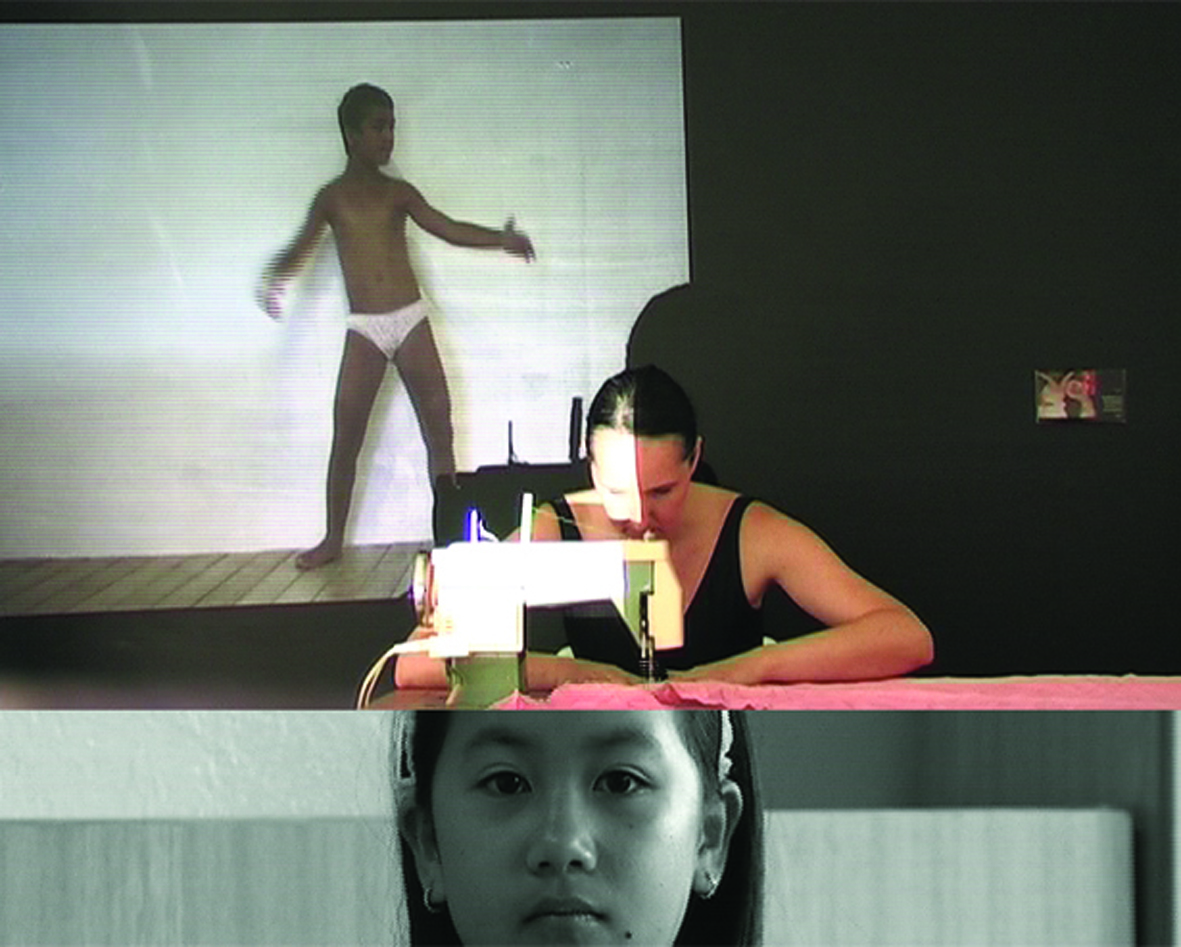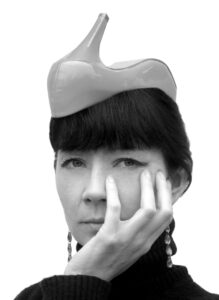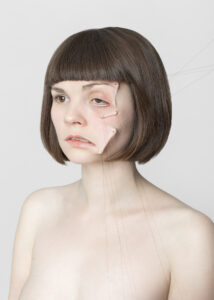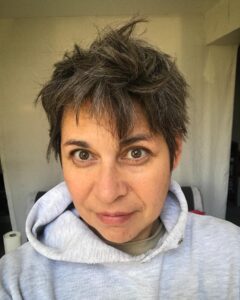Sráč Sam
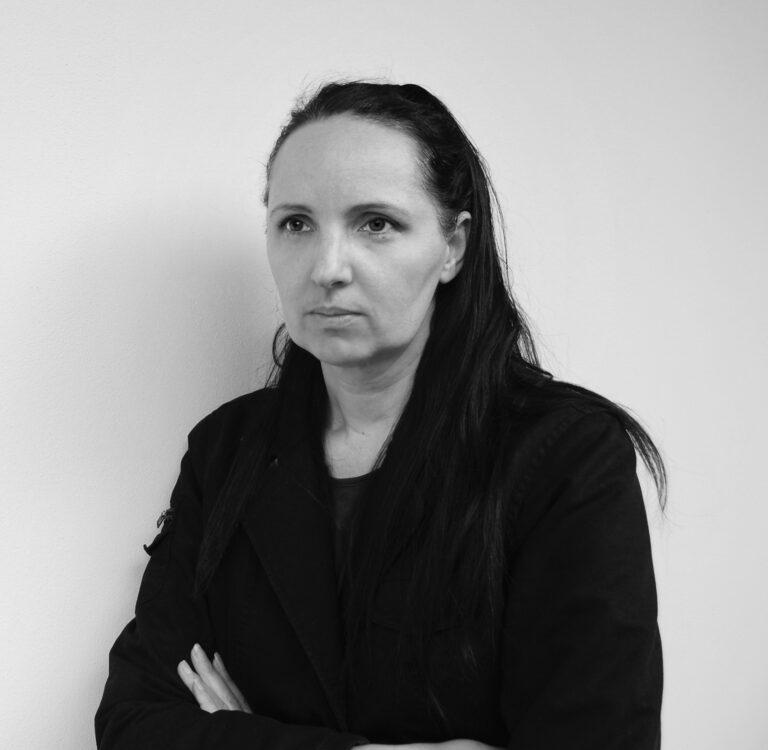
– born 1969. Her work involves the reassessment of the linguistic, visual, and social models that grow out of power relations. She founded the sam83 gallery, she organizes residencies Artist in Cottage, she publishes the independent magazine Pižmo, and she is the author the books Vanda (2011), Kuniba Likes Things in Threes (2011), and My Husband’s Fear (2017). By adopting a sense of socio-economic responsibility, she was among those artists who consciously anticipated the ethical shift in art.
The situations that Sam creates are environments in which she exposes the various aspects of manipulation and approaches to reality. In differing proportions, these scenarios move from the distinctly artificial, as explicit performances, to the completely natural, indistinguishable from reality. In every case the result is a new experience for the participant, even when it only concerns the recollection of memories.
In poverty and war, the status of women is the same as in abundance and peace. ~Sráč Sam, lecture for Mothers Artlovers 2018.
Thirty years ago, I formulated my “Vision for New Culture and Its Place,” which I saw as a comprehensive approach to reality that would include the fields of economics, ecology, and sustainability. During my work, I also observed deviations from this hypothesis.
“The basic idea is the creation of suitable socio-cultural conditions for the automatic, natural transfer of information in order to ensure the sustained and compact development of a social culture without artificial frameworks.” (Vision for New Culture and Its Place, 1989).
—
Regardless of the form it takes, I see art as a transformational tool of society. In my work, I focus on identifying power structures. I seek out and analyze prevailing linguistic models that evoke and in a certain manner are imbued with trust – not only thanks to established and proven rhetoric but primarily because of associated constructs regarding truthfulness and the only acceptable order. I see the movement of today’s art in a certain regression rather than in expansive creation. More in observation than in production. In the search for other, though the same and familiar, possibilities for communicating, the search for the preconditions for a not only linguistic but also visual reading. Disregard as a basis for trusting in what is different.
One of the first documented works in which I explored the contemporary socio-political context and the status of women was the 1985 performance Šumavan1. The performance was held in the exterior of the Šumavan textile factory in Klatovy, where I worked as a seamstress. The photographs ironize the image of “proud women of socialist labor” that one could encounter every day in the era’s newspapers and magazines. Against the backdrop of this industrial setting, two of us appeared as seamstresses, enacting various activities while parodying the fulfilment of economic plans. Another element of this image is the female workers’ sexuality as reflected in their body language. Unlike Western feminism, it integrates the will to work with physical attractiveness. One aspect of the totalitarian system was the suppression of identity, which in factories was reflected in the form of the working uniforms. This element appeared in the contrast of having one performer dressed in civilian clothes and the other dressed in the working outfit of the Šumavan factory.
A later work that covered the questions that I tend to explore in my work is In What Manner (2014)2. This short performance for four protagonists consisted of a sound installation of heavy breathing and wheezing, accompanied by the obsessively repeated phrase “In what manner, in what manner” – a looped recording of a priest’s sermon. In the live performance, set against the backdrop of a dark video projection of cellar doors letting in light, two women in nurses’ uniforms from the 1970s ceremonially carry in a two-dimensional cut-out of a vague figure covered in asphalt. A third person, her face covered with a ponytail, lights the sacrificial figure’s head on fire, and uses the dripping asphalt to christen the “Scripture” throughout the evocative loop. Subsequently, the nurses, wearing surgical masks and rubber gloves, use surgical forceps to offer the audience various items to eat from a glass dish, while a fourth figure reads texts from Pižmo. The audience is explicitly manipulated into a situation where they have to decide whether to accept the strange gift or reject it. Although it is a highly unpleasant situation, it is far from real manipulation.
Generally speaking, I have always seen the invisible work of women as a wrong that I have explored on several occasions (e.g., Šumavan, 1985; Ironing, 19903; The Mother’s Role, 19994; Blanket, 20075; Seamstresses, 20086) but that is not a natural part of my life. I feel a sense of responsibility from being able to draw on earlier waves of feminism. In my personal life, I do not differentiate between genders. My critical views pertain primarily to the media image of gender roles, which tend to conveniently confirm experienced reality. I comment on the banality of negligible stereotypes as aggression.
Text was created in cooperation with Denisa Tomková (2021).
1Image: Šumavan, 1985, performance, photo-documentation: artist’s archives, see: sracsam.cz/sumavan-1985/2Image: Jakým způsobem [In what manner], 2014, performance, photo artist’s archives, see: sracsam.cz/jakym-zpusobem/
3Image: Žehlení [Ironing], 1990, performance, photo František Motl, see: sracsam.cz/zehleni-1990/
4Image: Role matky [Mother’s Role], 1999, performance, photo Eva Hajšmanová, see: sracsam.cz/a1999/
5Image: Přikrývka [Cover], 2007, sewn object,see: sracsam.cz/prikryvka/
6Image: Šičky [Seamstresses], 2008, 5:26 min. video, see: sracsam.cz/sicky/
– narozena 1969, se ve své práci věnuje přehodnocování jazykových, vizuálních a sociálních vzorců. Založila galerii sam83, organizuje rezidenční pobyty Umělec na chatě, vydává nezávislý časopis PIŽMO a knižně vydala texty Vanda, Kuniba má rád věci třikrát a Strach mého muže. Nastavením vlastní socio-ekonomické odpovědnosti patří k umělkyním, které předjímaly etický obrat v umění. Situace, které uvádí, jsou prostředí, v nichž demonstruje polohy manipulace a přístupů ke skutečnosti. V různém poměru přechází od výrazně artificiálních, jako jsou performance, po zcela přirozené, které jsou od reality nerozlišitelné. Výsledkem je nová zkušenost účastníka, i když může jít jen o vyvolání vzpomínky.
V bídě a válce je postavení žen stejné jako v dostatku a míru. ~ Sráč Sam, přednáška pro Mothers Artlovers 2018.
Před třiceti lety jsem formulovala Vizi pro novou kulturu a její místo jako komplexní přístup ke skutečnosti zahrnující oblast ekonomiky, ekologie a udržitelnosti. Při práci jsem zároveň pozorovala odchylky od této hypotézy.
„Základní ideou je vytvoření vhodných sociokulturních podmínek pro automatický, přirozený převod informací, tím zajistit trvale kompaktní rozvoj sociální kultury bez umělých rámců.“ (Vize pro novou kulturu a její místo, 1989).
—
Umění vnímám jako transformační nástroj společnosti bez ohledu na jeho formu. Ve své práci se věnuji označování mocenských struktur. Hledám a rozkládám převládající jazykové vzory, které vyvolávají a určitým způsobem vlastní důvěru nejen díky zažitým osvědčeným rétorikám, ale především přidruženými konstrukty o správnosti a jediném řádu. Pohyb dnešního umění spatřuji spíš v určité regresi než v expanzivní tvorbě. Více v pozorování než v produkci. Hledání dalších komunikačních stejných, známých možností. Hledání na předpokladech schopnosti nejen jazykového, ale vizuálního čtení. Bezohlednost jako základ důvěry v odlišné.
Jednou z prvních zdokumentovaných akcí, ve kterých jsem reflektovala společensko-politický dobový kontext a postavení ženy, byla performance Šumavan1 z roku 1985. Performance se odehrávala v exteriéru textilní továrny Šumavan v Klatovech, kde jsem pracovala jako šička. Fotografie ironizují mediální obraz “hrdých pracovnic socialistické práce”, které byly v dobovém tisku na denním pořádku. Na pozadí industriálního prostředí jsme jako dvě šičky přehrály různé výkonnostní činnosti a parodovaly plnění ekonomického plánu. Dalším prvkem obrazu byla sexualita dělnic obsažená v gestech. Na rozdíl od západního feminismu integruje vůli pracovat s tělesnou přitažlivostí. Součástí totalitního systému bylo potlačování identity, které se v továrnách demonstrovalo v podobě pracovních uniforem. Tento prvek se objevil na kontrastu, kdy jedna performerka byla oblečena v civilním oděvu a druhá v pracovním oblečení příslušící továrně Šumavan.
Pozdější prací, která by pokryla otázky, kterými se obecně zabývám, je performance Jakým způsobem (2014). Krátké představení o čtyřech protagonistech složené ze zvukové instalace těžkého dechu a sípání s obsedantním opakováním Jakým způsobem, jakým způsobem2. Zasmyčkovaná nahrávka projevu kněze. Na pozadí temné videoprojekce sklepních dveří vpouštějících světlo se odehrává živá performance, kdy dvě zdravotní sestry ve stejnokroji ošetřovatelek ze sedmdesátých let obřadně přinesou dvourozměrnou maketu neurčité postavy pokrytou asfaltem. Třetí postava s ohonem v obličeji začne ohněm obětní figuře opalovat hlavu a odkapávajícím asfaltem křtí „písmo“ po dobu sugestivně doznívajícího loopu. Následně zdravotní sestry v rouškách a gumových rukavicích začnou publiku peánem ze skleněné nádoby nabízet neurčité předměty k jídlu, zatímco čtvrtá figura čte texty z Pižma. Návštěvníci jsou explicitně vmanipulováni do situace, zda podivný dar přijmout nebo odmítnout. Přestože jde o velmi nepříjemný stav, zdaleka se neblíží reálné manipulaci.
Obecně jsem v neviditelné práci žen vždy viděla křivdu, kterou jsem několikrát reflektovala (Šumavan, 1985; Žehlení, 19903; Role matky, 1999;4 Přikrývka, 20075; Šičky, 20086 aj.), ale v životě ji nemám přirozeně zahrnutou. Cítím odpovědnost k tomu, že mohu těžit z předchozích vln feminismu. V blízkém soužití rodové rozdělení nerozlišuji. Kriticky vnímám především mediální obraz rolí generující účelnost potvrzování zažitého. Komentuji banalitu zanedbatelných stereotypů jako agresi.
Text vznikl ve spolupráci s Denisou Tomkovou (2021).
1Obrázek: Šumavan 1985, performance, fotodokumentace archiv autora, viz: sracsam.cz/sumavan-1985/2Obrázek: Jakým způsobem, 2014, performance, fotodokumentace archiv autora, viz: sracsam.cz/jakym-zpusobem/
3Obrázek: Žehlení, 1990, performance, fotodokumentace František Motl, viz: sracsam.cz/zehleni-1990/
4Obrázek: Role matky, 1999, performance, fotodokumentace Eva Hajšmanová, viz: sracsam.cz/a1999/
5Obrázek: Přikrývka, 2007, šitý objekt, viz: sracsam.cz/prikryvka/
6Obrázek: Šičky, 2008, 5:26 min video, viz: sracsam.cz/sicky/
